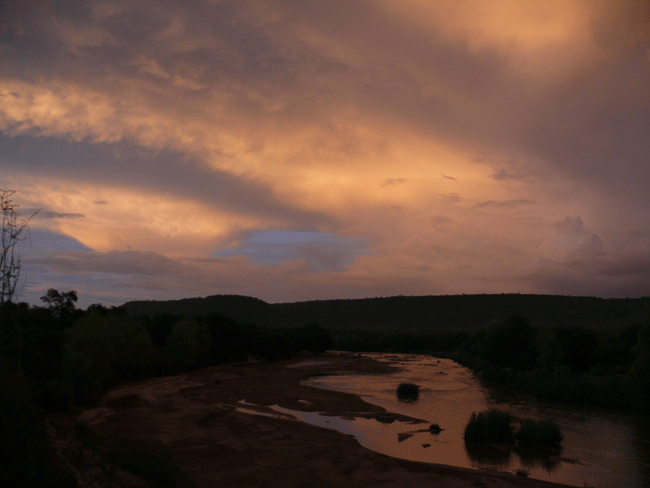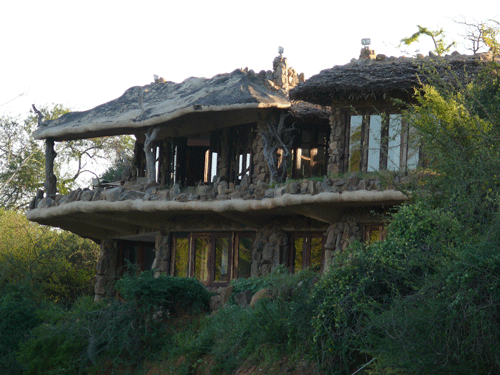Kulafumbi - The Land
Kulafumbi is the name of the wonderful place where my husband Ian and I are lucky enough to live, situated on the confluence of the Athi and Mtito Rivers. The Athi River is Kenya's second largest, and flows year round from its source near Nairobi, Kenya's capital city. The Mtito River, a small tributary, is seasonal, and therefore only flows during the rainy season. It is fed from the Chyulu Hills, to the west, which also feed the Mzima Springs, a source of water for Mombasa, Kenya's second largest city.
The land borders the Tsavo East National Park on two sides - the two rivers being the boundary between us and the Park. As our house sits right where the two rivers meet, the view from our balcony is out over the rivers and the National Park. The Yatta Plateau, allegedly the longest lava flow in the world, follows the Athi River on the far bank, and provides a stunning, ever changing backdrop to the river.
Because we have no fences between our property and the Park, the wildlife comes and goes between the two, sensing no difference. We maintain our property purely as a conservation area. You can see from our ongoing species counts (in the menu bar on the right) how many animals and birds have already realised that this is a safe haven for them, where they can live out their lives undisturbed.
The property is predominantly covered by Acacia and Commiphora bushland, overlooked by giant Baobab Trees and the more delicate Delonix Trees. At first glance, the bushland is grey, thorny and lifeless - how deceptive first impressions can be! In this dry country, nature and diversity thrive, for the wild species (unlike domestic stock) have evolved over millennia to live in these apparently inhospitable environments. On closer inspection, it is incredible to see how many different species of plants, animals, birds, and insects survive here.
The exception to the dry grey bushland, is the green oasis-line created by the river - a thin band of greenery and large lush trees which snakes its way through the dry country - an Eden of Doum Palms, Fig Trees, Tana River Poplars, Acacia, Salt Bush and Reeds - a magnet for all the wildlife, whether resident on the river or coming there to quench its thirst.
The rain - though scarce and infrequent - brings almost instant transformation to the property, as the grey bushland turns green almost overnight. The plants here have very fast reproductive cycles, for they have to flower and seed very quickly before the dry times set in again. As a result, it is miraculous to observe the changes from a dry grey thorny scrubland, to a carpet of green adorned by flowers of every colour, hue and description.
In theory, we have two annual rainy seasons here: The Short Rains in November/December and the Long Rains in April/May/June - although these days the weather patterns seem to be so disturbed that often the rain does not come at all.
Kulafumbi - The House
The name "Kulafumbi" literally means "eat dust" in Kiswahili - a reference to the conditions while building in this tinder-dry, remote part of Kenya. Every step of the way, the building of this house has been a challenge because the property is so far from any infrastructure or services. There is no electricity, no water mains, no sewage network - nothing. Everything had to be built here from scratch, powered by generators, and using water from the river. Even the building blocks were made by hand, right here. Luckily my father, a professional film-maker by trade who built the house, had had a year's engineering training as a youngster (before deciding a career in wildlife film-making was more to his liking). This experience, combined with a lifetime lived in the bush in Africa where you have to be self-sufficient for everything, allowed him to conceive of and manage the whole project - quite a feat when you see the finished item. My cousin, Ian, a structural engineer based in South Africa, flew up to spend a month with us - while he was here, he kindly designed all the structural elements of the house, ensuring that there are enough supports with enough steel in them to make sure this big, rock-laden house does not suddenly fall down. Another Ian - my husband - and I continue to nurture the house, which continues to be a work in progress, and I suspect, it always will be.
How does one describe a house like Kulafumbi? It is quite unlike any other I have ever seen. It is like the Flintstones meeting a Moorish architect, with more than a little unconventionality thrown in. The house is shaped to follow the river course, so that each room has its own special view. We live upstairs mainly, on the first floor which has a balcony running the whole way around it. Downstairs are our guest rooms, and our office. Although the house is entirely privately built and owned, as a donation to Tsavo Trust and the African Environmental Film Foundation, the non-profit charities for which we work, we have donated the use of half the downstairs as an office. We have satelite internet which allows us to manage these organisations from here in "the middle of nowhere". The flat roof of the house, reached by a gorgeous rustic staircase, is also a fabulous space - especially to spend a star-spangled night. It also houses our solar panels for hot water and our satellite dish.
The house is built "organically", using as many natural materials gathered from our own land as possible. The walls are of natural rock, collected from the river bed, the water and sand came from the river too, and most of the wood used was dead wood, washed up ready-seasoned onto our beach by previous floods. The remainder of the wood is old railway sleepers, from the original Kenya-Uganda railway, of 'Out of Africa' fame - beautiful old Indian Teak and Jarra hardwood, now discarded by the railways in the wake of modernization - what better way to recycle the wood than to use it for our window frames? So, the only building materials which we had to bring in from outside were the cement, the glass and the steel for reinforcing. I think, therefore, we can justly say that this is an example of eco-building at its best.
The house seen from the riverbed, looking up
The house as seen from behind (the river is beyond the house, although you cannot see it here
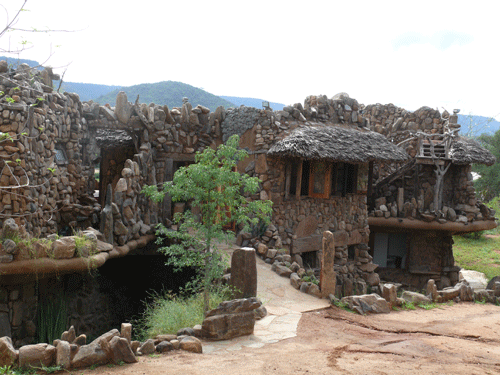
View from our bedroom window...
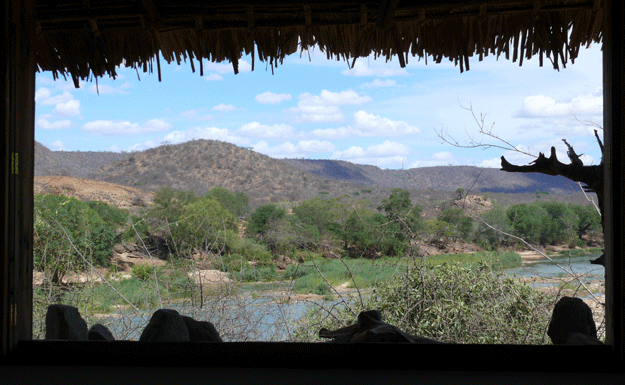
The house has already become part of the natural environment again, colonized by all kinds of creatures from the Agama Lizards and Genets to the myriad collection of birds which frequent our birdbath. Add to them, all the wild plants which grow in the "flowerbeds" lining the balcony and even adorn the rooftop. We've decided only to plant indigenous species both in our "flowerbeds" and "garden". Many plants are self-seeding on our balcony of their own acccord, so it's always fun seeing what pops up. I won't write too much about it here, as you'll see and meet all the resident plants and animals during the course of this journal...
If you look closely, in the far left-hand side of the photo below, you can just see our house, right on the corner where the small Mtito River can seen flowing into the much larger Athi River. The large white sandbank towards the right is visible from our balcony, and continues out of sight around the corner, to what we call Hippo Bend, where we have a resident pod of hippos. Up behind, you can see the bush airstrip on the neighbouring property - this is where we go running to try and keep fit...This photo was taken by my husband Ian, at the height of the rainy season, so the surrounding bushland is green and lush - for most of the year, however, the surrounding landscape is predominantly brown, with the river courses wending their green way through the dryness, and providing an oasis for all life in the vicinity...
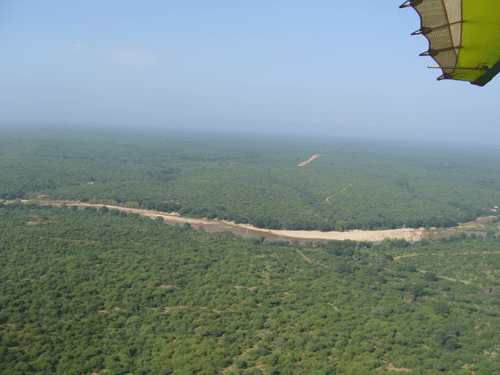
View a Photo-Journal of the Changing Seasons at Kulafumbi...





